Application of Drone LiDAR Survey for Evaluation of a Long-Term Consolidation Settlement of Large Land Reclamation
Abstract
1. Introduction
2. Methodology
2.1. LiDAR Measurement
2.2. Point Cloud Preprocessing
2.3. Surface Settlement Measure
2.4. Long-Term Settlement Prediction
3. Experimental Results
3.1. Drone
3.2. Data Acquisition
3.3. Data Comparison
3.4. Long-Term Settlement Prediction and Consolidation Rate
3.5. Use of Drone Survey for Areas without Ground Targets
4. Discussion
5. Conclusions
Author Contributions
Funding
Institutional Review Board Statement
Informed Consent Statement
Data Availability Statement
Conflicts of Interest
References
- Siebert, S.; Teizer, J. Mobile 3D mapping for surveying earthwork projects using an Unmanned Aerial Vehicle (UAV) system. Autom. Constr. 2014, 41, 1–14. [Google Scholar] [CrossRef]
- Howard, J.; Murashov, V.; Branche, C.M. Unmanned aerial vehicles in construction and worker safety. Am. J. Ind. Med. 2017, 61, 3–10. [Google Scholar] [CrossRef]
- Mukhamediev, R.I.; Symagulov, A.; Kuchin, Y.; Zaitseva, E.; Bekbotayeva, A.; Yakunin, K.; Assanov, I.; Levashenko, V.; Popova, Y.; Akzhalova, A.; et al. Review of some applications of unmanned aerial vehicles technology in the resource-rich country. Appl. Sci. 2021, 11, 10171. [Google Scholar] [CrossRef]
- Oh, J.H.; Lee, C.N. 3D power line extraction from multiple aerial images. Sensors 2017, 17, 2244. [Google Scholar] [CrossRef] [PubMed]
- Bognot, J.; Candido, C.G.; Blanco, A.C.; Montelibano, J.R.Y. Building construction progress monitoring using unmanned aerial system (UAS), low-cost photogrammetry, and geographic information system (GIS). ISPRS Ann. Photogramm. Remote Sens. Spat. Inf. Sci. 2018, 4, 41–47. [Google Scholar] [CrossRef]
- Oh, J.H.; Jang, Y.J.; Lee, C.N. Accuracy analysis of low-cost UAV photogrammetry for corridor mapping. J. Korean Soc. Surv. Geod. Photogramm. Cartogr. 2018, 36, 565–572. [Google Scholar]
- Kaamin, M.; Asrul, N.; Daud, M.E.; Suwandi, A.K.; Sahat, S.; Mokhtar, M.; Ngadiman, N. Volumetric change calculation for a landfill stockpile using UAV photogrammetry. Int. J. Integr. Eng. 2019, 11, 53–62. [Google Scholar]
- Baiocchi, V.; Napoleoni, Q.; Tesei, M.; Servodio, G.; Alicandro, M.; Costantino, D. UAV for monitoring the settlement of a landfill. Eur. J. Remote Sens. 2019, 52, 41–52. [Google Scholar] [CrossRef]
- Seong, H.W. Proposal of a Model for Construction Error Analysis of RC Pile Foundation Using a Drone and Validation through a Case Study. Master’s Thesis, Chung-ang University, Seoul, Republic of Korea, 2020. [Google Scholar]
- Tanda, G.; Balsi, M.; Fallavollita, P.; Chiarabini, V. A UAV-based thermal-imaging approach for the monitoring of urban landfills. Inventions 2020, 5, 55. [Google Scholar] [CrossRef]
- Jung, K.Y.; Park, J.K. Roughness analysis of paved road using drone LiDAR and images. J. Korean Soc. Surv. Geod. Photogramm. Cartogr. 2021, 39, 55–63. [Google Scholar]
- Suleymanoglu, B.; Gurturk, M.; Yilmaz, Y.; Soycan, A.; Soycan, M. Comparison of unmanned aerial vehicle-LiDAR and image-based mobile mapping system for assessing road geometry parameters via digital terrain models. Transp. Res. Rec. 2023, 2023, 1–10. [Google Scholar] [CrossRef]
- Park, J.K.; Jung, K.Y. Accuracy evaluation of earthwork volume calculation according to terrain model generation method. J. Korean Soc. Surv. Geod. Photogramm. Cartogr. 2021, 39, 47–54. [Google Scholar]
- Lee, S.B.; Jeong, M.; Auh, S.C.; Kim, J.J. Development of standard work type to utilize drone at expressway construction sites. KSCE J. Civ. Environ. Eng. Res. 2021, 41, 461–478. [Google Scholar]
- Mandirola, M.; Casarotti, C.; Peloso, S.; Lanese, I.; Brunesi, E.; Senaldi, I. Use of UAS for damage inspection and assessment of bridge infrastructures. Int. J. Disaster Risk Reduct. 2022, 72, 102824. [Google Scholar] [CrossRef]
- Cienciał, A.; Sobura, S.; Sobolewska-Mikulska, K. Optimising land consolidation by implementing UAV technology. Sustainability 2022, 14, 4412. [Google Scholar] [CrossRef]
- Liu, X.; Zhu, W.; Lian, X.; Xu, X. Monitoring mining surface settlement with multi-temporal three-dimensional unmanned aerial vehicle point cloud. Remote Sens. 2023, 15, 374. [Google Scholar] [CrossRef]
- Zheng, J.; Yao, W.; Lin, X.; Ma, B.; Bai, L. An accurate digital settlement model for deformation detection of coal mining areas using a UAV-based LiDAR. Remote Sens. 2022, 14, 421. [Google Scholar] [CrossRef]
- Ganesan, R.; Raajini, X.M.; Nayyar, A.; Sanjeevikumar, P.; Hossain, E.; Ertas, A.H. BOLD: Bio-Inspired Optimized Leader Election for Multiple Drones. Sensors 2020, 20, 3134. [Google Scholar] [CrossRef]
- Yayli, U.C.; Kimet, C.; Duru, A.; Cetir, O.; Torun, U.; Aydogan, A.; Padmanaban, S.; Ertas, A. Design optimization of a fixed wing aircraft. Adv. Aircr. Spacecr. Sci. 2017, 4, 65–80. [Google Scholar] [CrossRef]
- Choo, Y.S.; Kim, J.H.; Hwang, S.H.; Chung, C.K. The optimization of hyperbolic settlement prediction method with the field data for preloading on the soft ground. J. Korean Geotech. Soc. 2010, 26, 147–159. [Google Scholar] [CrossRef]
- Asaoka, A. Observational procedure of settlement prediction. Soils Found. 1978, 18, 87–101. [Google Scholar] [CrossRef] [PubMed]
- Muller, A. Assessment of Vertical Accuracy from UAV-LiDAR and Structure from Motion Point Clouds in Floodplain Terrain Mapping. Master’s Thesis, Portland State University, Portland, OR, USA, 2021. [Google Scholar]
- Kucharczyk, M.; Hugenholtz, C.; Zou, X. UAV-LiDAR accuracy in vegetated terrain. J. Unmanned Veh. Syst. 2018, 6, 212–234. [Google Scholar]
- Shibata, T.; Shuku, T.; Murakimi, A.; Nishimura, S.; Fujisawa, K.; Hasegawa, N.; Nonami, S. Prediction of long-term settlement and evaluation of pore water pressure using particle filter. Soils Found. 2019, 59, 67–83. [Google Scholar]
- Park, H.; Kim, H. Analysis of the settlement of Pusan new port construction site using the settlement prediction methods. In Proceedings of the International Symposium on Urban Geotechnics 2009, Inchoen, Korea, 25–26 September 2009. [Google Scholar]

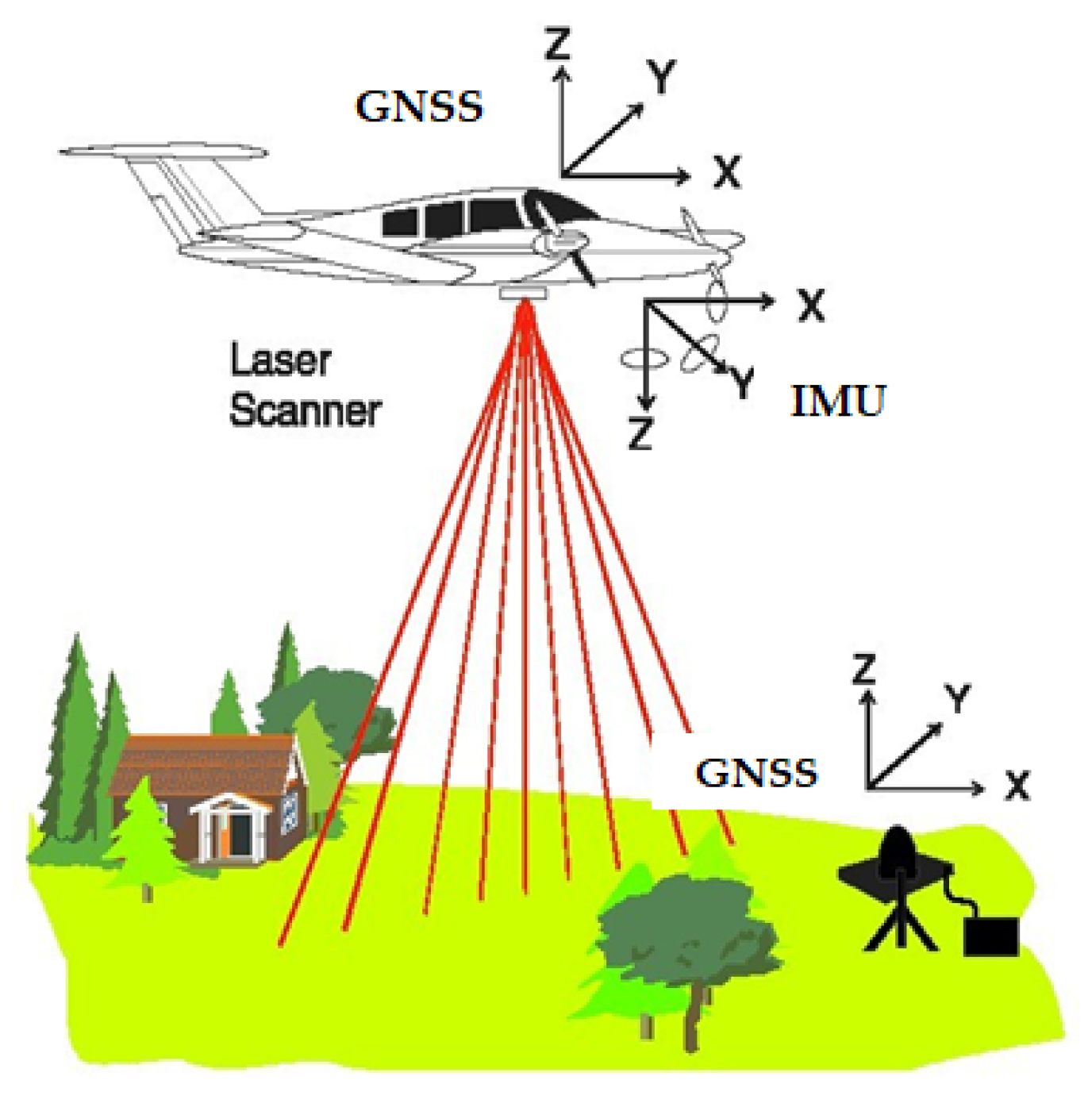
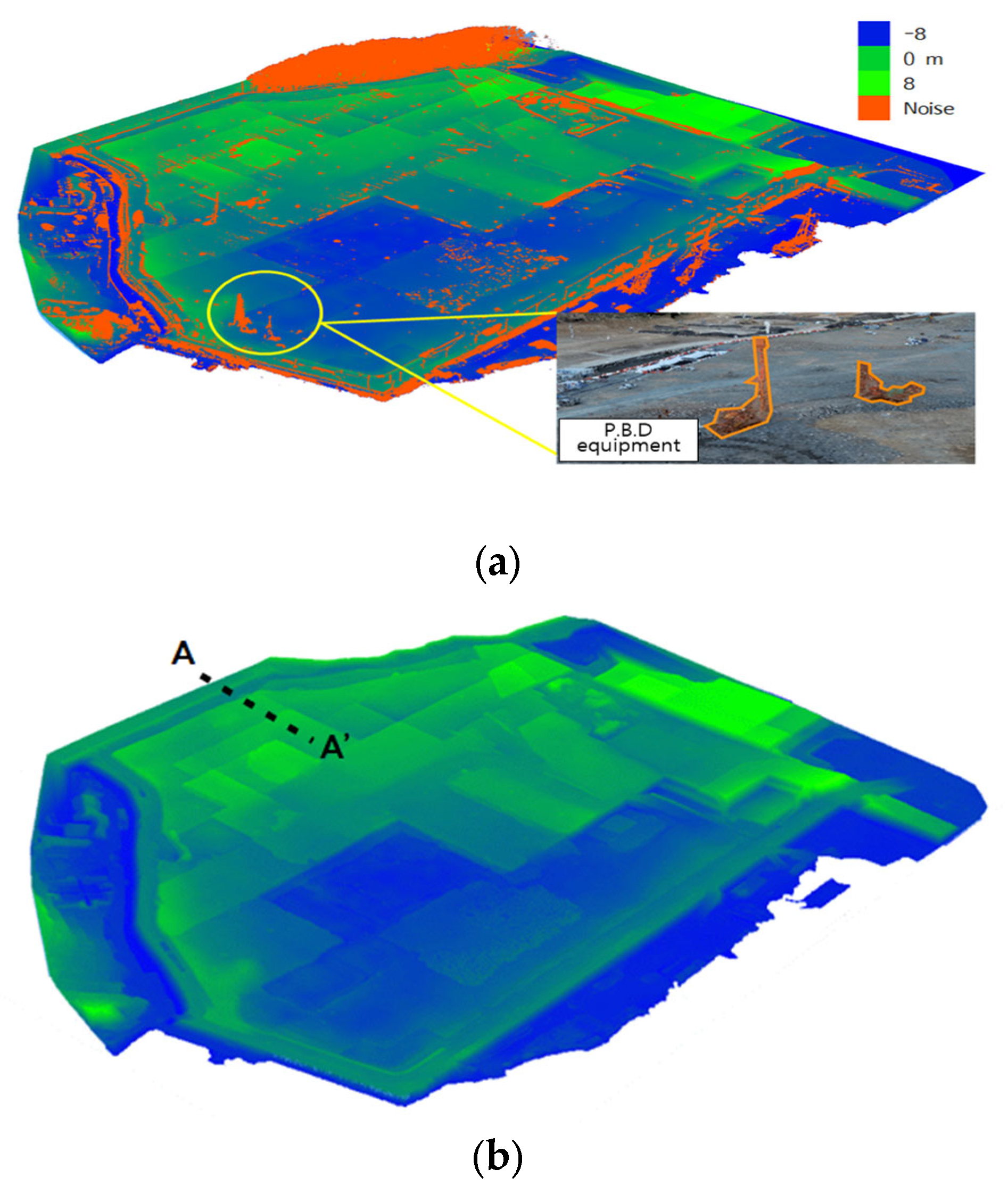
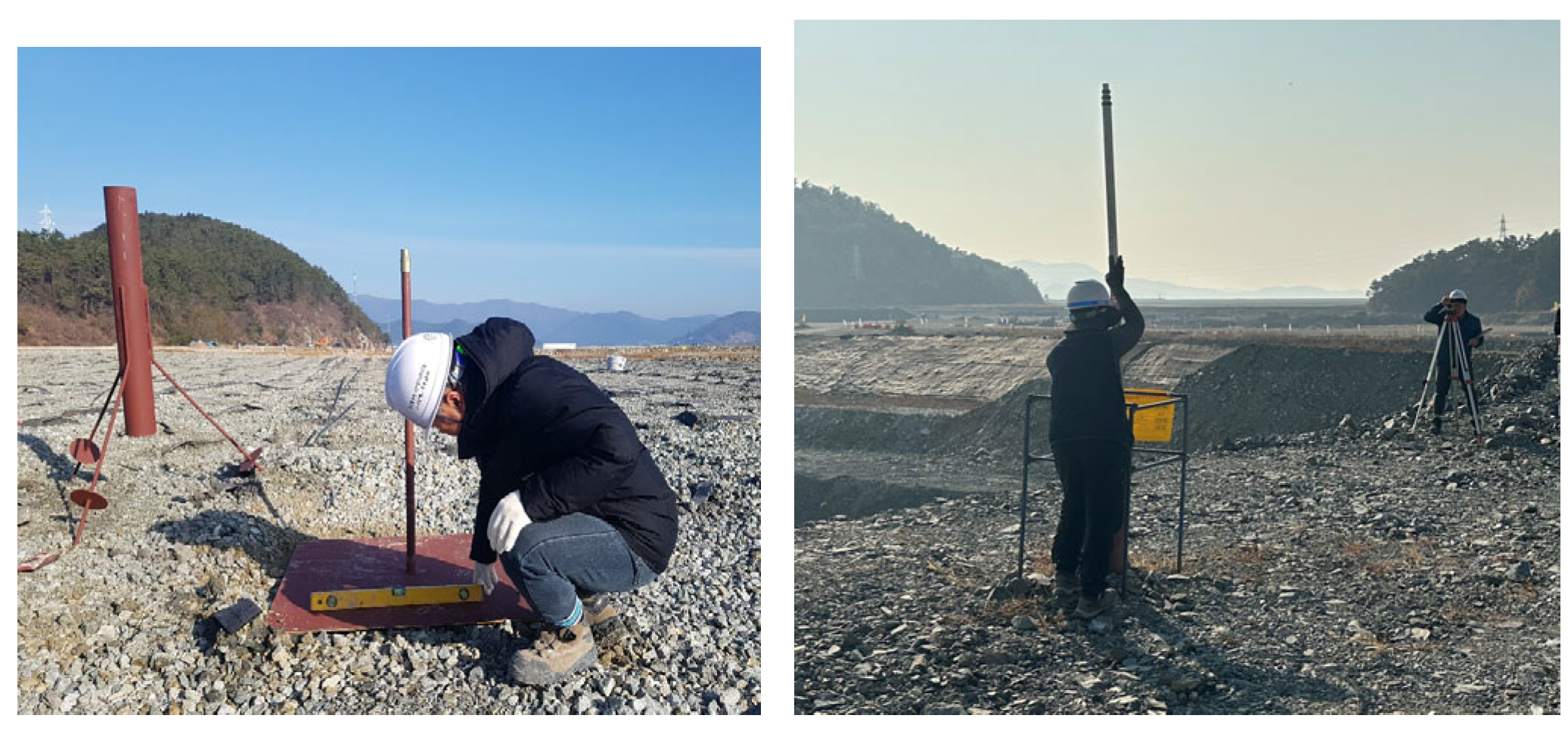
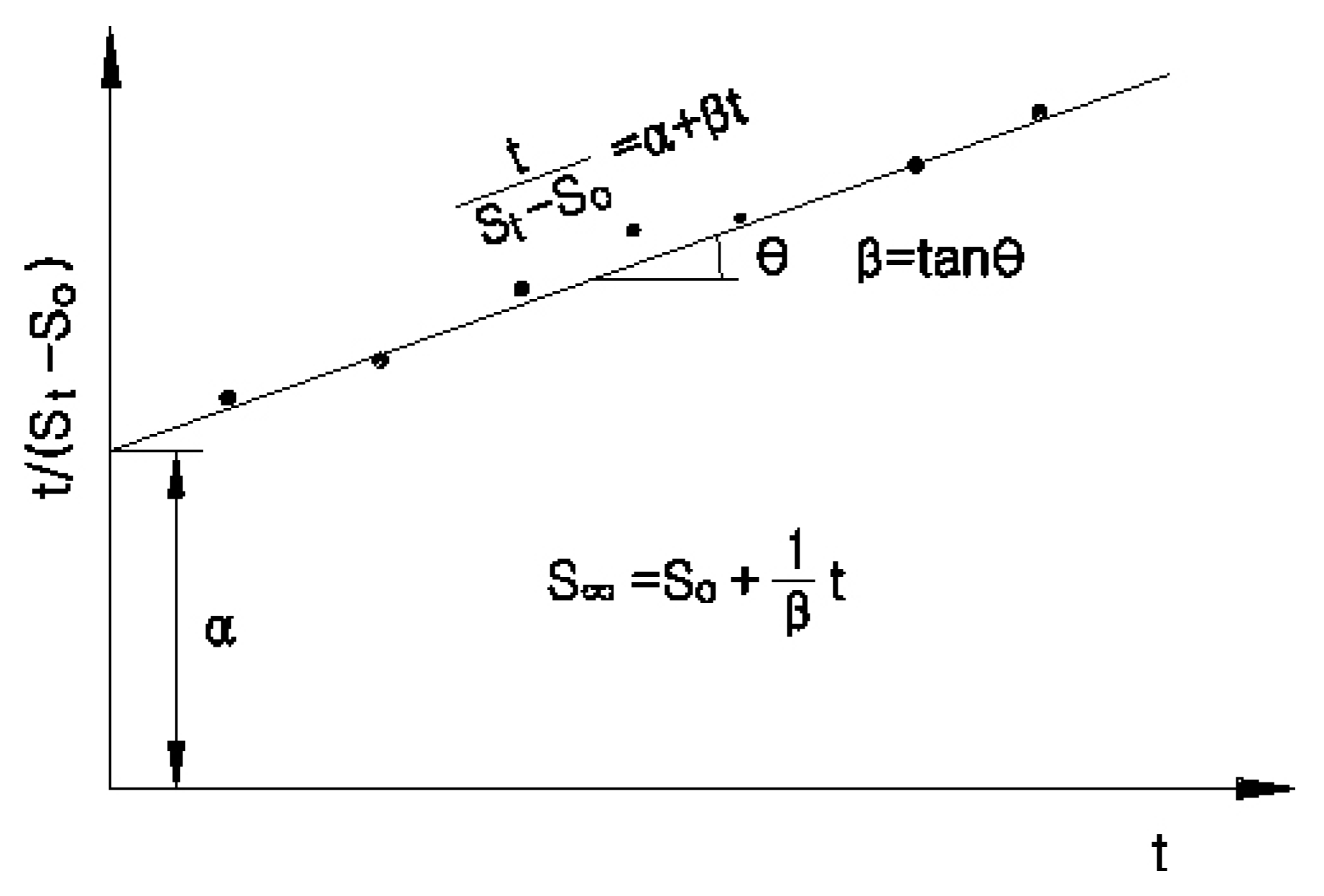
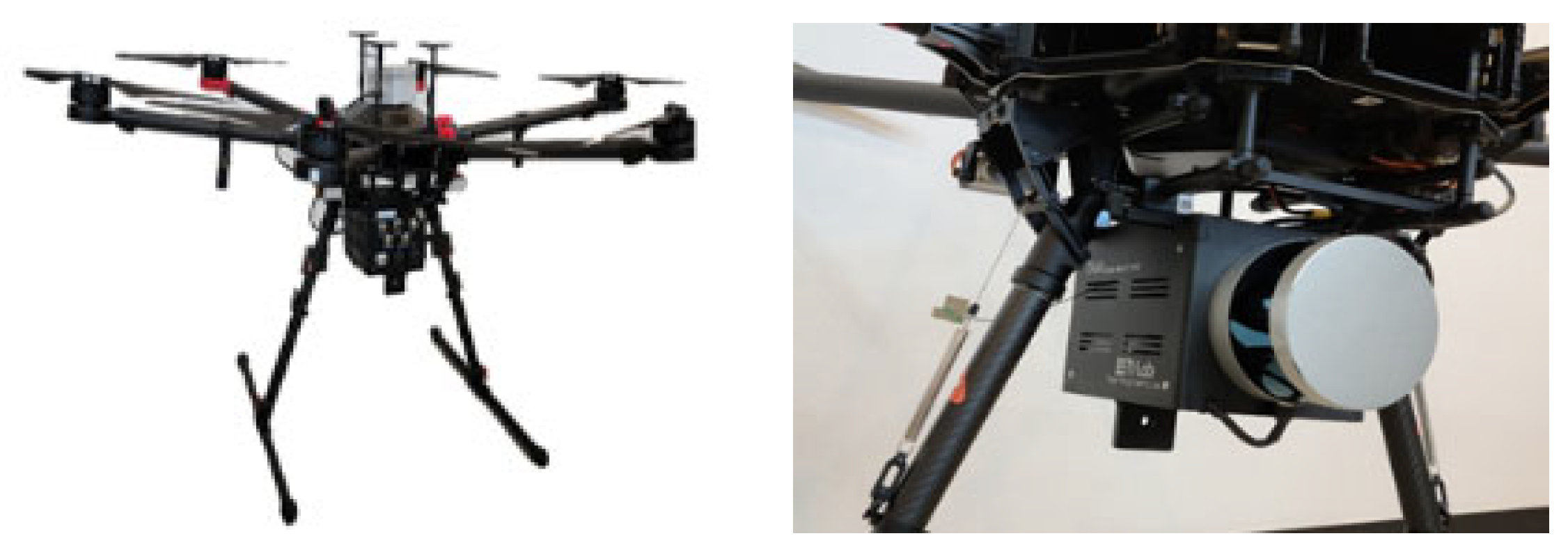


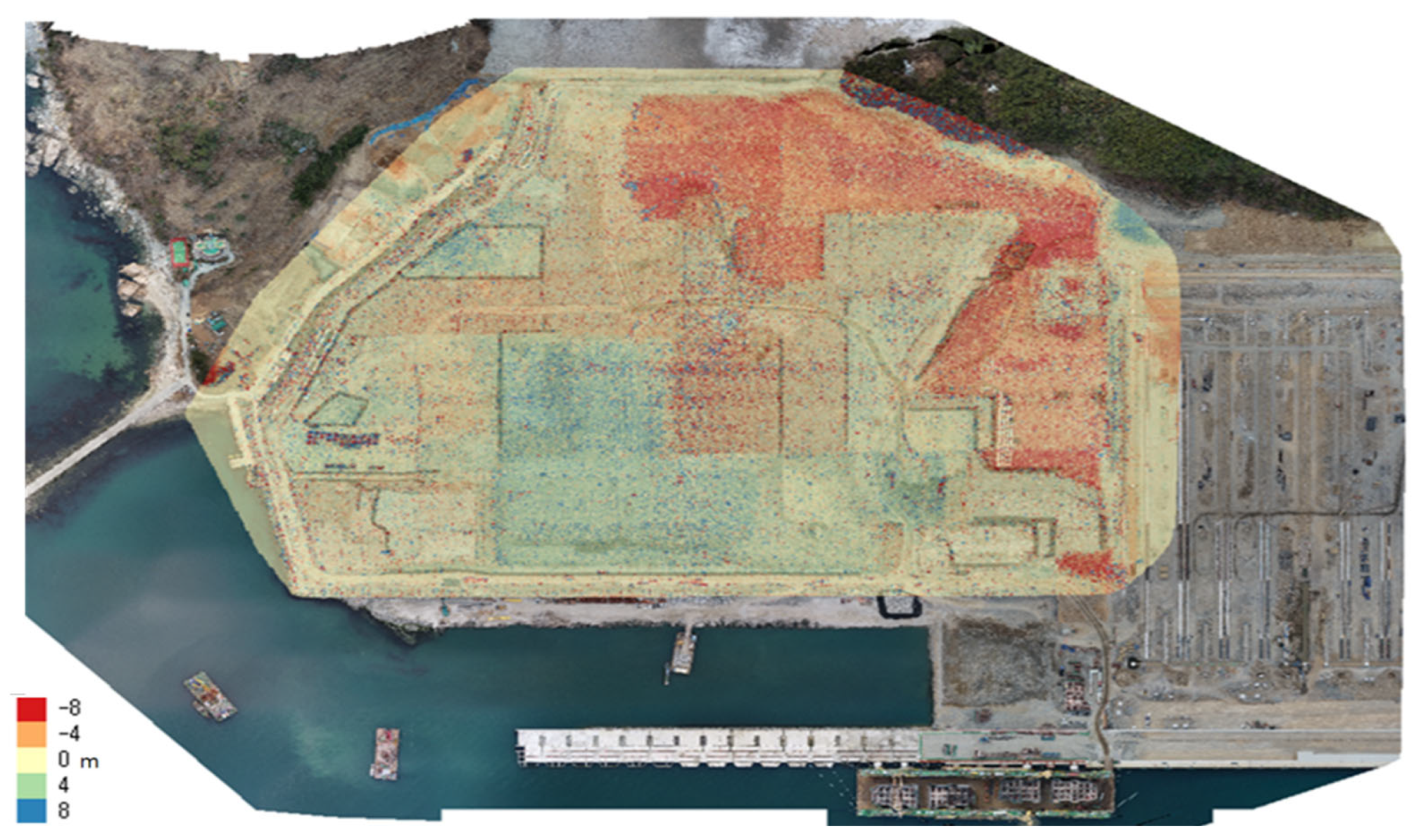

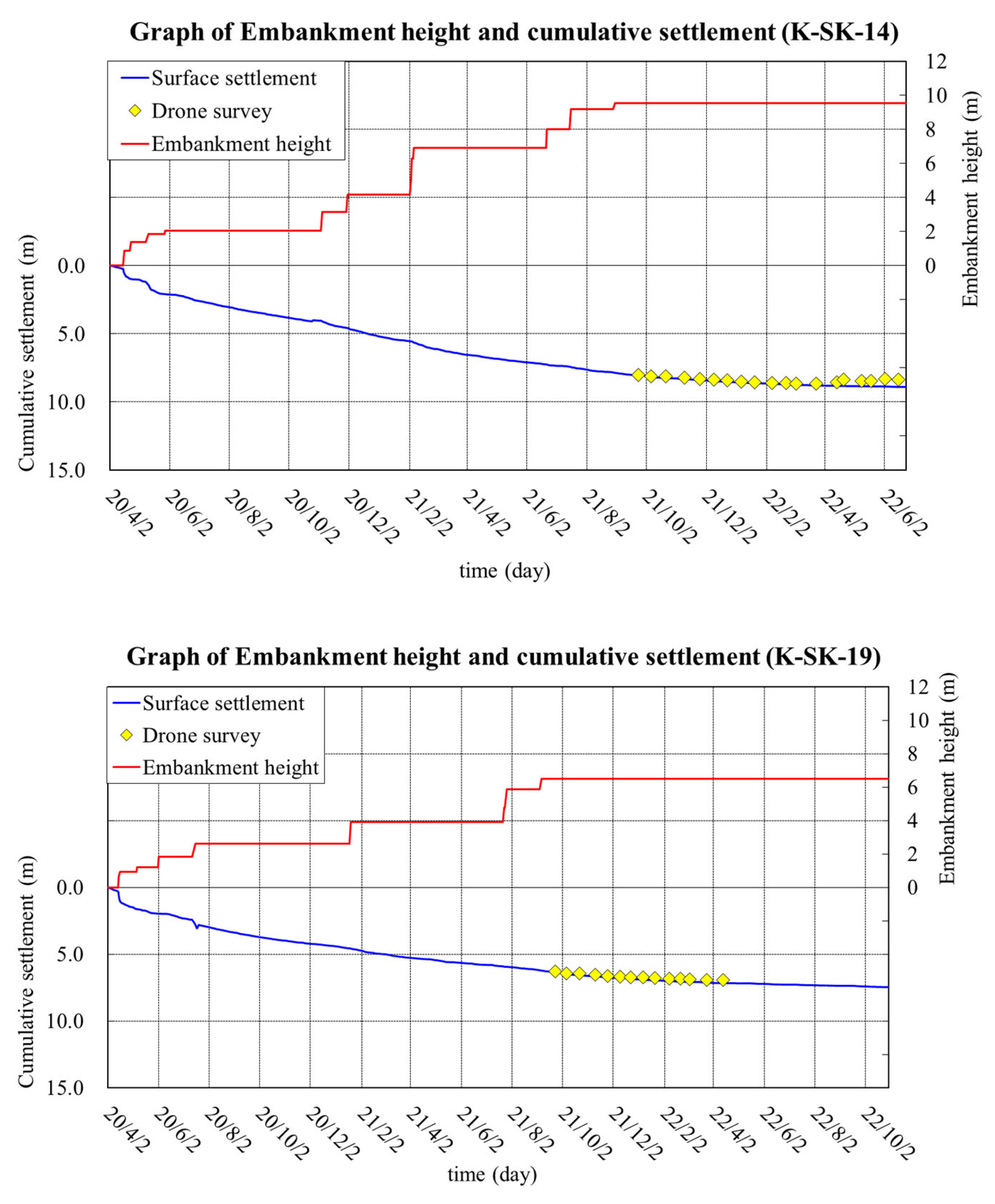
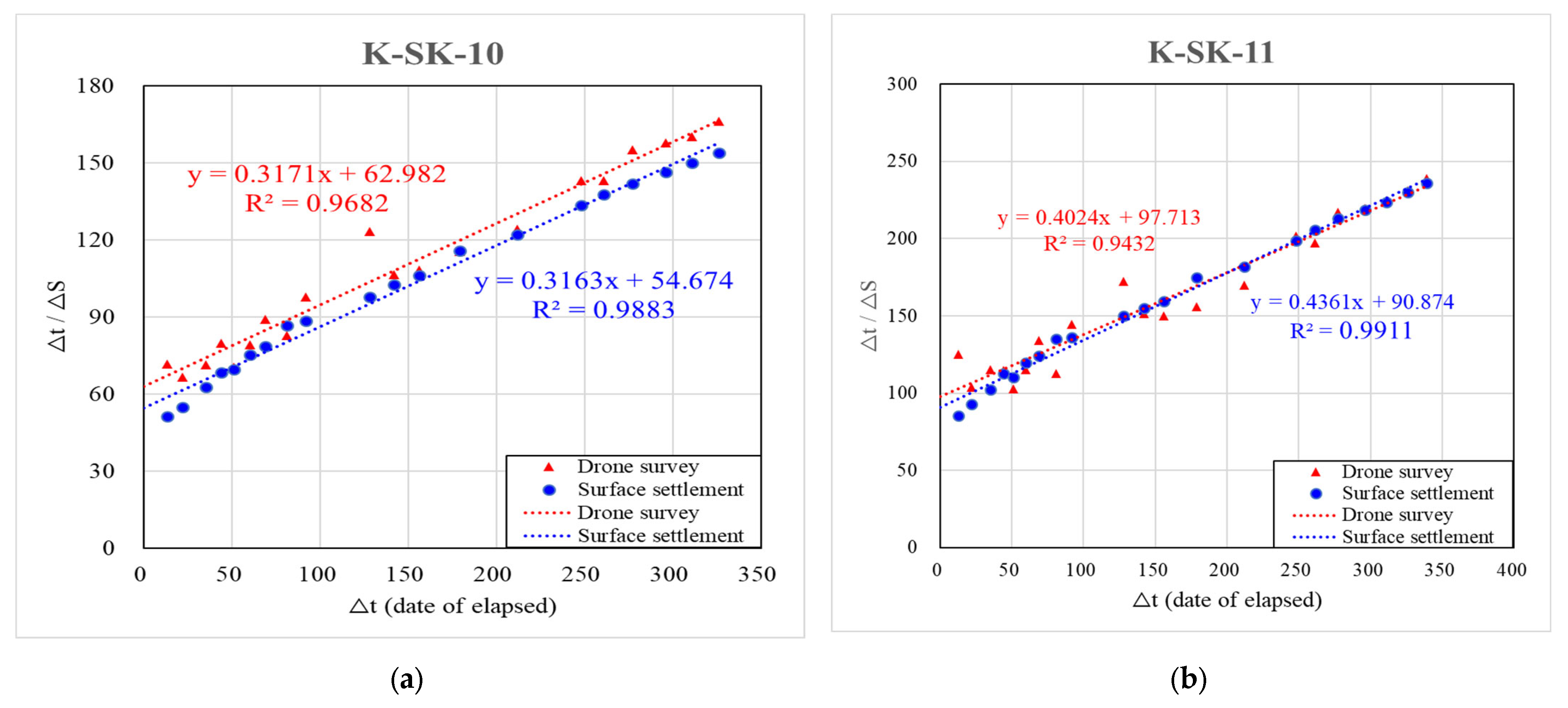
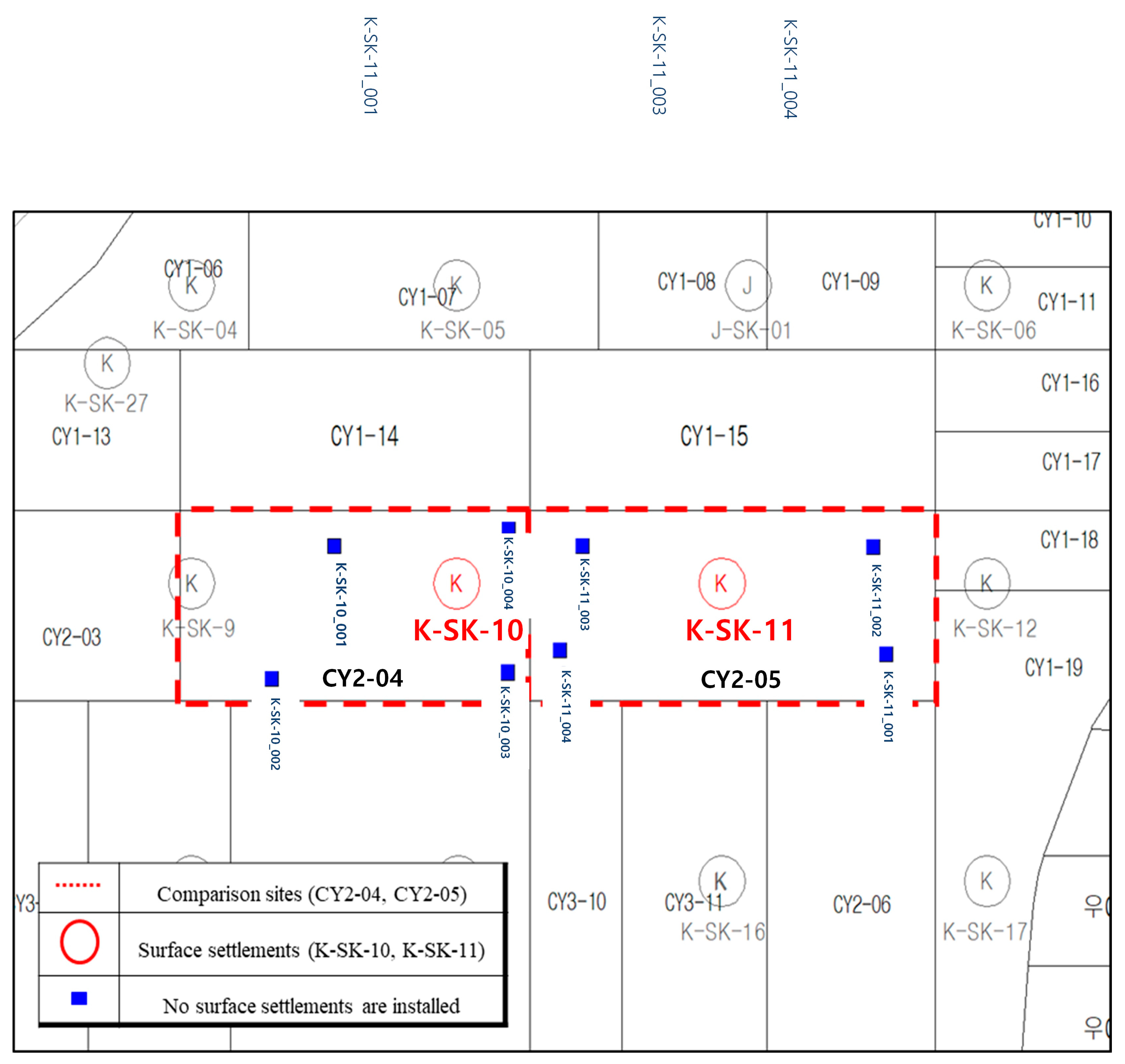
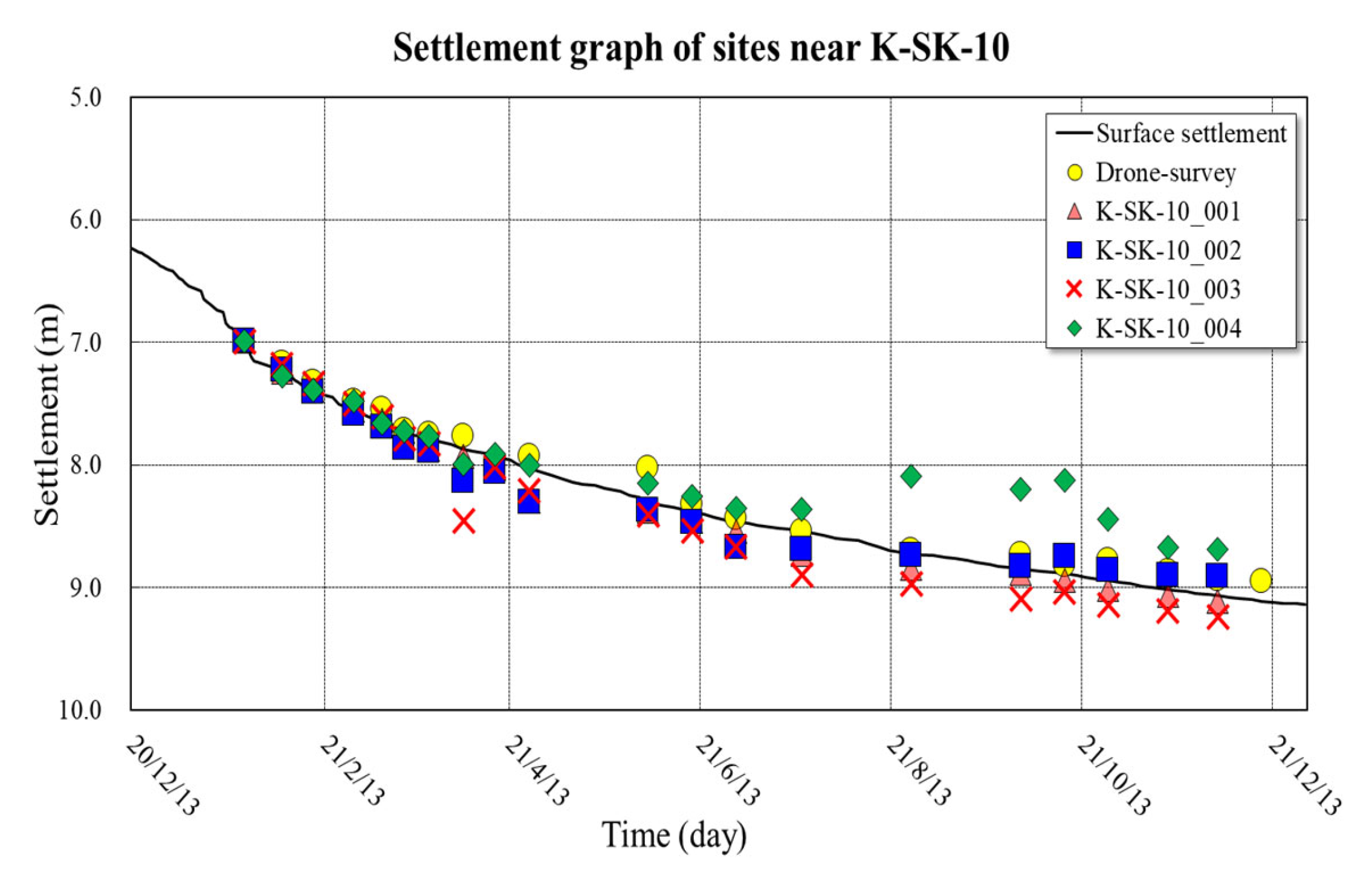
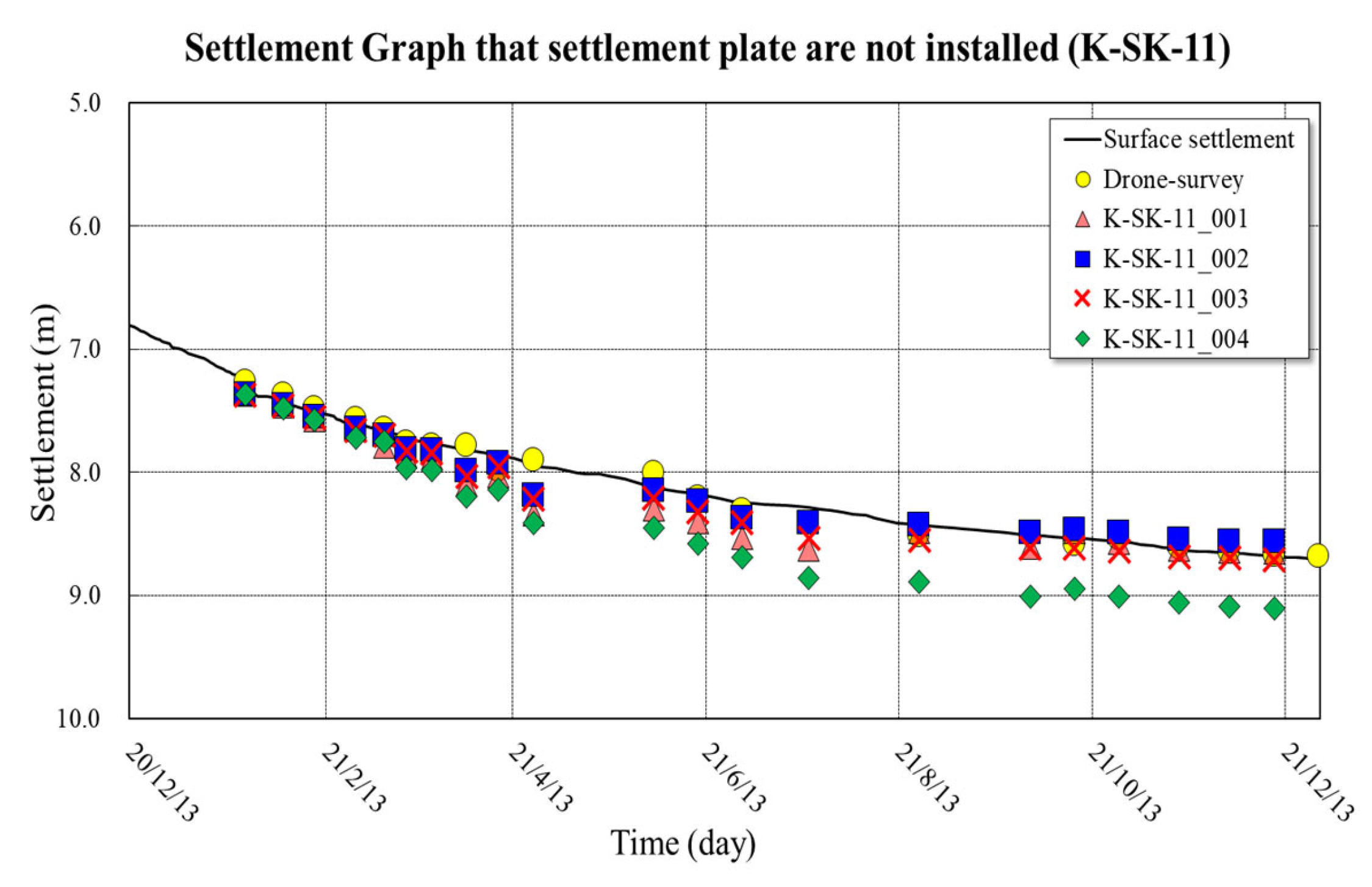
| Item | Specifications |
|---|---|
| LiDAR sensor | Velodyne Puck VLP-16 |
| Field of View | 360° × 30° |
| Maximum distance | 100 m |
| Scan rate | 0.3 million points/s |
| Accuracy | Below ±3 cm |
| IMU | APX 15 |
| Roll/Pitch | 0.015 deg |
| No. | Location | Measurements | Num of Data |
|---|---|---|---|
| 1. | K-SK-10 | Daily or 1 per 3 days | 116 |
| 2 | K-SK-11 | Daily or 1 per 3 days | 120 |
| 3 | K-SK-14 | Daily or 1 per 3 days | 89 |
| 4 | K-SK-19 | Daily or 1 per 3 days | 137 |
| No. | Location | Measurements | Num of Data |
|---|---|---|---|
| 1 | K-SK-10 | 1~2 per month | 21 |
| 1 | K-SK-11 | 1~2 per month | 22 |
| 1 | K-SK-14 | 1~2 per month | 19 |
| 1 | K-SK-19 | 1~2 per month | 14 |
| Location | Averaged Difference over Time (mm) | RMSE Difference over Time (mm) |
|---|---|---|
| K-SK-10 | −84 | 109 |
| K-SK-11 | 6 | 56 |
| K-SK-14 | −185 | 254 |
| K-SK-19 | −90 | 101 |
| Drone Survey | Surface Settlements | Difference | ||||
|---|---|---|---|---|---|---|
| Predicted Settlement (m) | Predicted Consolidation (%) | Predicted Settlement (m) | Predicted Consolidation (%) | Predicted Settlement Difference (mm) | Consolidation Rate Difference (%) | |
| K-SK-10 | 3.154 | 62.17 | 3.162 | 67.06 | −8 | −4.88 |
| K-SK-11 | 2.485 | 57.15 | 2.293 | 62.71 | 192 | −5.56 |
| K-SK-14 | 0.476 | 71.77 | 1.382 | 63.33 | −906 | 8.44 |
| K-SK-19 | 1.085 | 58.73 | 1.420 | 53.29 | −335 | 5.43 |
| RMSE | 492 | 6.23 | ||||
| Location | Predicted Settlement (m) | Consolidation (%) | |
|---|---|---|---|
| K-SK-10 (surface) | 0.988 | 3.162 | 67.1 |
| K-SK-10 | 0.968 | 3.154 | 62.2 |
| K-SK-10-001 | 0.990 | 2.560 | 71.1 |
| K-SK-10-002 | 0.990 | 2.629 | 73.0 |
| K-SK-10-003 | 0.935 | 3.737 | 60.2 |
| K-SK-10-004 | 0.895 | 1.788 | 94.7 |
| K-SK-11 (surface) | 0.991 | 2.293 | 62.7 |
| K-SK-11 | 0.943 | 2.485 | 57.1 |
| K-SK-11-001 | 0.922 | 2.034 | 62.6 |
| K-SK-11-002 | 0.968 | 2.018 | 59.0 |
| K-SK-11-003 | 0.968 | 2.479 | 53.5 |
| K-SK-11-004 | 0.934 | 3.477 | 49.3 |
Disclaimer/Publisher’s Note: The statements, opinions and data contained in all publications are solely those of the individual author(s) and contributor(s) and not of MDPI and/or the editor(s). MDPI and/or the editor(s) disclaim responsibility for any injury to people or property resulting from any ideas, methods, instructions or products referred to in the content. |
© 2023 by the authors. Licensee MDPI, Basel, Switzerland. This article is an open access article distributed under the terms and conditions of the Creative Commons Attribution (CC BY) license (https://creativecommons.org/licenses/by/4.0/).
Share and Cite
Lee, J.; Jo, H.; Oh, J. Application of Drone LiDAR Survey for Evaluation of a Long-Term Consolidation Settlement of Large Land Reclamation. Appl. Sci. 2023, 13, 8277. https://doi.org/10.3390/app13148277
Lee J, Jo H, Oh J. Application of Drone LiDAR Survey for Evaluation of a Long-Term Consolidation Settlement of Large Land Reclamation. Applied Sciences. 2023; 13(14):8277. https://doi.org/10.3390/app13148277
Chicago/Turabian StyleLee, Joonghee, Hyeonjeong Jo, and Jaehong Oh. 2023. "Application of Drone LiDAR Survey for Evaluation of a Long-Term Consolidation Settlement of Large Land Reclamation" Applied Sciences 13, no. 14: 8277. https://doi.org/10.3390/app13148277
APA StyleLee, J., Jo, H., & Oh, J. (2023). Application of Drone LiDAR Survey for Evaluation of a Long-Term Consolidation Settlement of Large Land Reclamation. Applied Sciences, 13(14), 8277. https://doi.org/10.3390/app13148277







